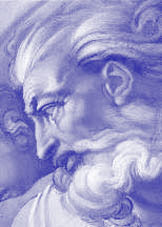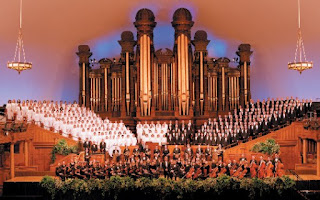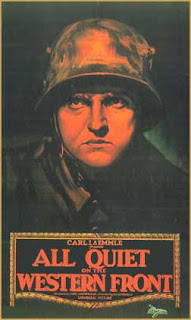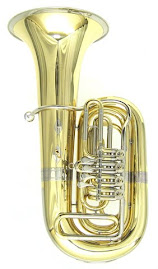 30-40 Years Left
30-40 Years LeftA woman named Shirley lived in Beverly Hills, California. One day, she suffered a heart attack and was taken to Cedars Sinai hospital. While on the operating table, she had a near-death experience. She saw God and asked, "Is this it?" God said, "No, you have another 30 to 40 years to live."
Upon her recovery, she decided to stay in the hospital and have collagen shots, cheek implants, a face-lift and liposuction. She figured that since she had another 30 to 40 years left, she might as well make the most of it. She walked out of Cedars Sinai lobby after the last operation and was immediately killed by an ambulance speeding up to the hospital.
She arrived in front of God and said, "I thought you said I had another 30 to 40 years?"
God replied, "Shirley! I didn't recognize you!"
From the Choir Loft
 Before being accepted into the 360 voice Mormon Tabernacle Choir, applicants undergo a rigorous six-month, three-phase audition process. Prospective choir members must be active members of The Church of Jesus Christ of Latter-day Saints, be recommended by the bishop of their local congregation, live within 100 miles of downtown Salt Lake City, and be between the ages of 25 and 55. The first step of the audition process is to submit a recording of an acappella solo selected by Craig Jessop, music director. Jessop and Associate Director Mack Wilberg review the mountain of submitted tapes to decide which singers they will invite to the next phase of the audition process. Candidates must take a written music skills test, which measures musical ability and aptitude. Candidates must score a minimum of 80 % to progress to the third step of the audition — the "in-person" audition. Standing before Jessop and Wilberg, anxious singers perform a hymn of their choice, demonstrate their sight-reading skills and test their vocal range and ability to blend. Final selections are then made at the end of the six-month cycle, and a group of new voices is added to the Choir family. However, the process is not quite complete. The selected singers are brought into the Temple Square Chorale for a three-month period during which they sing with the Chorale and attend musical training classes taught by Jerrold Ottley, former director of the Choir, and his wife, JoAnn. Upon successful completion of the training program, new members "graduate" into the Mormon Tabernacle Choir. In January 2002, 860 singers requested applications and 350 submitted sample tapes. Of those, 140 were invited to take the musical skills test and 90 were invited for an in-person audition. Finally, only 65 singers, less than 10 percent of the original applicants, were accepted into the Choir.
Before being accepted into the 360 voice Mormon Tabernacle Choir, applicants undergo a rigorous six-month, three-phase audition process. Prospective choir members must be active members of The Church of Jesus Christ of Latter-day Saints, be recommended by the bishop of their local congregation, live within 100 miles of downtown Salt Lake City, and be between the ages of 25 and 55. The first step of the audition process is to submit a recording of an acappella solo selected by Craig Jessop, music director. Jessop and Associate Director Mack Wilberg review the mountain of submitted tapes to decide which singers they will invite to the next phase of the audition process. Candidates must take a written music skills test, which measures musical ability and aptitude. Candidates must score a minimum of 80 % to progress to the third step of the audition — the "in-person" audition. Standing before Jessop and Wilberg, anxious singers perform a hymn of their choice, demonstrate their sight-reading skills and test their vocal range and ability to blend. Final selections are then made at the end of the six-month cycle, and a group of new voices is added to the Choir family. However, the process is not quite complete. The selected singers are brought into the Temple Square Chorale for a three-month period during which they sing with the Chorale and attend musical training classes taught by Jerrold Ottley, former director of the Choir, and his wife, JoAnn. Upon successful completion of the training program, new members "graduate" into the Mormon Tabernacle Choir. In January 2002, 860 singers requested applications and 350 submitted sample tapes. Of those, 140 were invited to take the musical skills test and 90 were invited for an in-person audition. Finally, only 65 singers, less than 10 percent of the original applicants, were accepted into the Choir. ‘A Mighty Fortress Is Our God’
(1930) page 110
Words and Music by: Martin Luther (1483-1546)
Translated by Frederick H. Hedge: (1805-1890)
Martin Luther was born on November 10, 1483 in Germany. He was educated at the University of Erfurt, later becoming an Augustinian monk, teaching philosophy and theology at the University of Wittenberg. On October 31, 1517, sometimes called the "July 4th of Protestantism," Martin Luther nailed his ninety-five theses to the door of the Roman Catholic Church. He was eventually excommunicated from the fellowship of the Roman Catholic Church later that year.
One of the important benefits of the Reformation Movement was the rediscovery of congregational singing inside the Church. Martin Luther had strong convictions about the use and power of sacred music. Luther once said, "the Devil hates music because he cannot stand gaiety, Satan can smirk but he cannot laugh; he can sneer but he cannot sing." This hymn was a tribute to Luther's friend Leonhard Kaiser, who was executed as a Protestant martyr on August 16, 1527. Luther was credited with writing at least 35 hymns.
The single most powerful hymn of the Protestant Reformation Movement was Luther’s ‘A Mighty Fortress Is Our God,’ based on Psalm 46. This hymn became the battle cry of the people, a great source of strength and inspiration even for those who were martyred for their convictions. The first line of this hymn is fittingly inscribed on the tomb of Martin Luther in Wittenberg, Germany. In March of 1969, this hymn was sung during the funeral service of American President Dwight D. Eisenhower at the National Cathedral in Washington, DC.
Meanwhile…1930…77 years ago…in the United States…
President: Herbert Hoover…V.P.: Charles Curtis
The song: ‘Happy Days Are Here Again’ becomes #1
Best Picture of the Year: ‘All Quiet On The Western Front’
The 1st radio broadcast of ‘Death Valley Days’ on NBC-Radio
George R.D. Braun was pastor of The Sheridan Methodist Church
Ref. TheSheridanSettler Cyberhymnal BuffaloHistory TanBible DmarieCapsule ColonialHall
Church office: (716) 672-2048, Bud: (716) 934-7734, email: tubamanbud@yahoo.com www.frombudsworld.blogspot.com











